Halifax Passenger Transport in the Mid-1960's - Part Four
Halifax Passenger Transport in the Mid-1960's - Part Four
Not read this article from the beginning, click here

262 (PXO 974) AEC Reliance MU3RV / Park Royal 'Royalist' C41C, new to Timpson's, London E6.
Following the success of the previous year's used coach purchase and with the Countryside Tour and Private Hire side doing well, a further five secondhand vehicles followed suit in 1966. Two (261/262, NRK 350 & PXO 974) had bodywork to Park Royal's relatively uncommon and shortlived 'Royalist' design, 261 - like MBY 347 - being new to Bourne & Balmer of Croydon, later passing to Timpson's, whereas 262 had been new to Timpson's. These acquired coaches were all subject to a confusing bout of renumberings during their time. Both were rebodied with Plaxton Panorama I bodies, and passed to WYPTE, PXO 974 being briefly used by WYPTE for staff transfer between Leeds and their headquarters in Wakefield before passing through various owners before being scrapped in 1980.
Here the two are seen parked in Commercial Street on a rather miserable Bank Holiday, rather optimistically touting for business on the usually very popular Countryside Tours.

263 & 264 (TGJ 486 & 485) AEC Reliance MU3RV / Burlingham 'Seagull Mk. V' C41F, new to Bourne & Balmer, Croydon in 1957.
261 (NRK 350) AEC Reliance MU3RV / Park Royal 'Royalist' C41C, new to Bourne & Balmer, Croydon in 1955.
In addition to the two Park Royal Royalists there were also three Reliances with Burlingham Seagull Mk. V front-entrance bodies (260/263/264, TGJ 484/486/485). 260 had been new to Timpson's, the other two (263/264) to Bourne & Balmer, Croydon, later passing to Timpson's. These suited the Halifax livery extremely well. A further similar vehicle - with Seagull Mk.IV body - was acquired in 1968 having been new to Yelloway of Rochdale in 1956. This (200, ODK 770) was only a stopgap purchase though, and was withdrawn the following year. 260 was rebodied with a new Plaxton Panorama I body and later passed briefly to WYPTE. 263 & 264 were not rebodied and were withdrawn in 1971.
These three are pictured inside Elmwood Garage.

258 (formerly 261) AEC Reliance MU3RV / Plaxton 'Panorama I' C43F, chassis new 1955, body new in 1968.
NRK 350 was withdrawn by WYPTE in 1975 and sold to a dealer who retained it for many years before scrapping it. Here it is passing Skircoat Garage and turning from Skircoat Road into the lower section of Free School Lane, towards Elmwood Garage.

268 (DJX 143D) Leyland Leopard L2 / Willowbrook DP41F, new in 1966.
Back in 1964 the first two dual-purpose single deckers had materialised as 269/270 (AJX 269/270B). Based on the Leyland Leopard L2 chassis they had Willowbrook 43-seater bodies incorporating the recently introduced BET-pattern curved windscreen, but instead of the latest style of peaked domes and curved rear windows Hilditch specified the standard protruding three section destination box and the earlier design of rounded rear dome - producing a unique 'Halifax look' which was to be applied to all new single deckers until 1973. Externally they bore a new partially reversed livery with cream lower panels and an orange band. The interiors were in pale grey and dark green with an attractive two-tone green and red seat moquette with white 'HPT' monogrammed antimacassors on the headrests. A further example arrived in 1965 (267, CJX 275C), being a 41-seater and with a kind of tartan seat moquette popular on coaches at the time, and in 1966 a similar fourth one (268, DJX 143D) came along. Used on stage services as well as tours and private hire these were pleasanter Leopards than the more spartan earlier bus versions, and proved to be very useful vehicles. 269 & 270 were later repainted into bus livery, and all four passed to WYPTE, 267/269/270 being withdrawn in 1976. 268 was substantially modified for bus use by the PTE, receiving a peaked front dome, being stripped of its shiny metal external trim and the luggage boot removed, and inside the luggage racks were removed and bus seats fitted, being finally withdrawn in 1981.
268 is seen waiting to operate a local Countryside Tour when quite new, in Commercial Street - just around the corner from the department's town centre premises in Back Commercial Street (but always referred to as Powell Street).

101 (ECP 681D) Daimler Fleetline CRG6LX/30 / Northern Counties H43/32F, new in 1966.
Following the successful demonstration of 565 CRW, a change of buying policy introduced Daimler Fleetlines into the fleet. Rear-engined double deckers had begun to appear in other places from 1958, but in 1966 they were still considered a novelty, causing many turned heads and puzzled expressions. Once again the local BET operator - Hebble Motor Services - had pipped the Corporation at the post by placing their first solitary Fleetline into service a couple of months earlier. Geoff Hilditch's last purchases in his previous post at Great Yarmouth had been Fleetlines with Roe bodies - having a curved windscreen but flat windows in the front of the upper saloon., and he would have preferred to buy similar vehicles for Halifax. However, due to the development of new housing estates to the Rastrick side of Brighouse - an area until then only served by single deckers - it was anticipated that soon double deckers would be needed, and there was another of those low arched railway bridges to contend with. Full height bodies were reckoned to be too high, but normal low height bodies were considered to be unnecessarily low, and something inbetween was preferable. Unfortunately Roe were not able to offer an intermediate height body at the time, but Northern Counties were, and the first seven (99-105, ECP 679-685D) entered service with the Corporation in September 1966, These had the curved screen/flat upper deck window style, and the engine bustle disguised with 'shrouds'. and the type became the standard Halifax double decker until the end. Hebble's Fleetline - which in 1971 would be absorbed into the JOC fleet - was surprisingly similar to the Halifax examples with only detail differences, and quite unlike any other Northern Counties bodies delivered to a BET Group company.
101 is seen negotiating the bend at Lee Bridge, returning to town from Bradshaw or Queensbury on the through service to Newlands. In later years 101 was regarded by the driving staff as having the heaviest steering of any bus in the fleet.

105 (ECP 685D) Daimler Fleetline CRG6LX/30 / Northern Counties H43/32F, new in 1966.
In the early days of the Fleetline type many crew drivers - used to years of driving halfcabs with no set-back front axle - found them a handful, and there were many scrapes as they learned the hard way how to position them in tight spots. Many did not like the eerie sensation of the engine sound being thirty feet behind them or the spongy hydraulic accelerator, and the 'easy-drive' fingertip controlled semi automatic gearbox was all too easily abused by those less conscientious drivers. Conductors could also now all too easily stand at the front and distract the driver's attention.
105 was the first of the type to enter service, and the writer recalls his first ride on it one Saturday afternoon on the West End Circular service, being driven by none other than manager Geoff Hilditch himself - who was accompanied by a rather nervous conductor ! Here it seen leaving Mount Tabor, approaching Sandy Fore, retracing the ill-fated 1920's trolleybus route on its way to Wainstalls.

105 (ECP 685D)
There were 47 generally similar Northern Counties-bodied Fleetlines delivered to both fleets between 1966 and 1973. One G-registered one (290) was returned to Daimler for use as a demonstrator in Cape Town after only a brief spell in service, and an identical replacement was provided taking the same number. Hebble's only bought-new Fleetline was taken into the JOC fleet (as 294) in 1971, along with an Alexander-bodied version (as Corporation 103) that Hebble had acquired from Yorkshire Woollen. Following the merger with Todmorden JOC in 1971, the later examples were built to a 'proper' lowheight specification in order that they could enter the low-roofed Todmorden Millwood Garage. More of the type were on order at the time of the WYPTE takeover in 1974, and these were eventually delivered to the Calderdale District fleet after lengthy delays - though with many changes to the original chassis and body specification. The Halifax Fleetlines eventually began to suffer structural problems around their front ends, with disturbing looking gaps appearing and windscreens prone to blowing out in high crosswinds ! The rear engine shrouds were found to be troublesome also, and so all were rebuilt in PTE days with strengthened fronts and the shrouds removed. Withdrawals commenced in 1980 and the last one served with Yorkshire Rider until 1990 (being recently acquired by a preservationist), although a few served a liitle longer as training buses.
Here 105 has now reached Wainstalls terminus beside the New Delight public house, reversed and is awaiting departure back to town and through to Causeway Foot - the borough boundary on the Keighley Road. The following year the route would be extended 200 yards along the road off the the left into the narrowest part of the village, where it would have to perform a difficult and very tight reverse on a blind corner onto to the terminus stop - typical of so many Halifax routes. This would mean a reversion to short halfcabs once more.

303 (FCP 303E) Dennis Loline III / Northern Counties H41/33F, new in 1967.
Roger had left Halifax by 1966, after which AEC Reliances - including some shortened, narrow ones to replace the Nimbuses, and more with Willowbrook DP and later Plaxton bodies, single-deck versions of the Fleetline, Seddon Pennine RU's, Dennis Lolines and finally Leopards in their later more powerful PSU4B form, appeared on the scene. These are really beyond the scope of theis article, but he was later to pay a return visit when he photographed Loline 303 climbing Salterhebble Hill (and passing the oddly named Elephant Terrace) on its way back to town from Huddersfield. So a liitle about the Lolines.
The private hire operation had along the way secured a lucrative contract to provide works transport for hundreds of female workers between towns in the Wakefield/Barnsley/Doncaster triangle and the Meredith & Drew (later United Biscuits) factory at Ovenden - tales of the antics of these 'ladies' being the stuff of legend. A large fleet of single deckers including DP's and the acquired coaches were required, but then consideration was given to replacing some of these with a lesser number of suitable double deckers in order to keep costs down and remain competitive, as the contract was renewable annually, and there were always other companies willing to jump in with a lower bid. There was also the perceived need to be able to provide appropriate double deckers for other longer distance private hire work in the future - preferably to a low height to allow for any low bridges that may have encountered. Most of the types available were unsuitable, but then thoughts turned to the Dennis Loline demonstrator that had visited in 1964. This had a Gardner 6LX engine, 4-speed semi-automatic gearbox and Northern Counties body, and had been intended for use as an overseas demonstrator, but the plan had not materialised. Further visits were arranged, then enquiries made regarding various changes to the specification - including a 5-speed gearbox - and then five were ordered. These (300-304, FCP 300-304E) came along in 1967 and were fine looking and comfortably specified vehicles, with high-backed seating, air-suspension at the rear and a fair turn of speed. Unfortunately mechanical troubles arose very soon afterwards and a Dennis service engineer was almost a resident of Halifax for quite a while as he tried to sort them out - the problems mostly arising from the complicated and congested transmission arrangements caused by the awkward fitting of the large 5-speed gearbox and transfer box in too tight a space. After only four years service it was decided to dispose of them, and they passed to the West Riding Automobile Co. who were desperately buying up Bristol Lodekkas to replace their ill-fated Guy Wulfrunians. It probably seemed that the Lolines would fit in well with the Lodekkas - from which the Loline was originally derived - and they did manage to obtain a further seven years out of them before they were finally scrapped in 1978.
In the years that followed, most of the stage operations of Hebble and all of Todmorden JOC's were taken over- considerably enlarging the route network and bringing about the replacement of the Halifax and Todmorden JOC's with the combined Calderdale JOC. Along with the municipal undertakings of Leeds, Bradford and Huddersfield, Halifax's operations were taken over by the West Yorkshire PTE in 1974, Halifax being served by their Calderdale District. At deregulation in 1986 a buyout by WYPTE directors led to the privately owned Yorkshire Rider, this in turn being bought out by Badgerline Holdings, then this by the Grampian Regional Transport Group leading to the formation of FirstBus. At first using the local identity of Calderline, FirstBus soon imposed its corporate look and it is only in the last year or so that the 'Halifax' local identity has reappeared. First Halifax has in recent years reduced dramatically in size, with very many of its routes being given up - due either to competition from local small operators, or New-Kid-on-the-Block CentreBus/Yorkshire Tiger outbidding them on tendered work.
Throughout this article reference to the following must be acknowledged:
'Steel Wheels and Rubber Tyres', Vol. Two, by Geoffrey Hilditch (The Oakwood Press, 2004)
'Halifax Passenger Transport From 1897 to 1963', by Geoffrey Hilditch (The Oakwood Press, 2006)
'Fleet History of Halifax Corporation....etc. ' (PSV Circle publication PB23, 1990)
All photographs by Roger Cox unless otherwise stated.
Text by John Stringer.
01/08/14 - 10:26
What a great article on Halifax by Roger Cox and John Stringer. Well done to you both.
In Part 1 they mention the 4 PD2s which went to Oldham in 1965 to assist with the vehicle shortage caused by the well known 'Ministry' fleet check.
The four were ACP 385, ACP 388, ACP 390 and ACP 392 given Oldham Fleet Nos. 465, 469, 470 and 467 respectively.
I have dug out a selection of pictures from my collection, of them working in Oldham.
Stephen Howarth
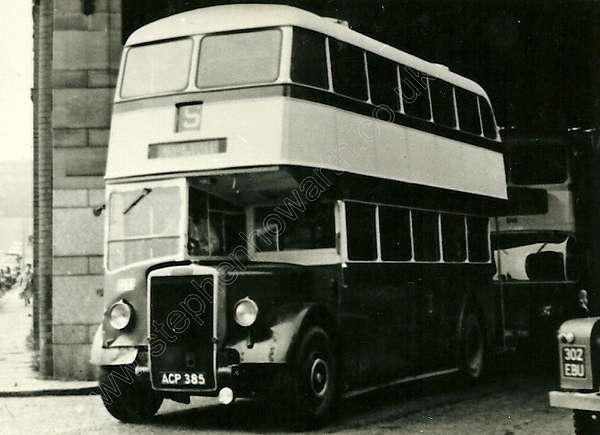
ACP 385 fleet number 465, exiting Wallshaw Street Garage crossing the appropriately named Car Street to take up a service 5. 302 EBU was the departments Land Rover. The garage exit is 54ft wide
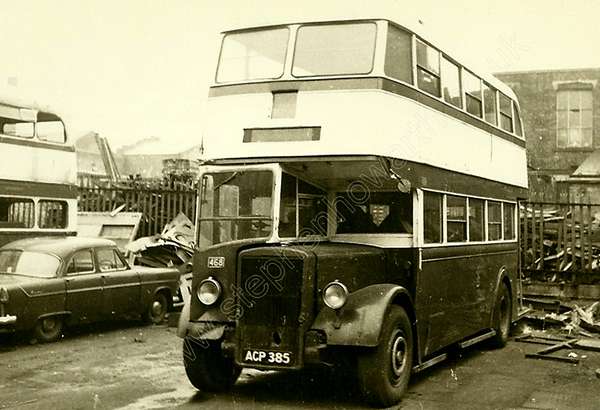
ACP 385 again in a withdrawn condition in the yard at Wallshaw Street Garage
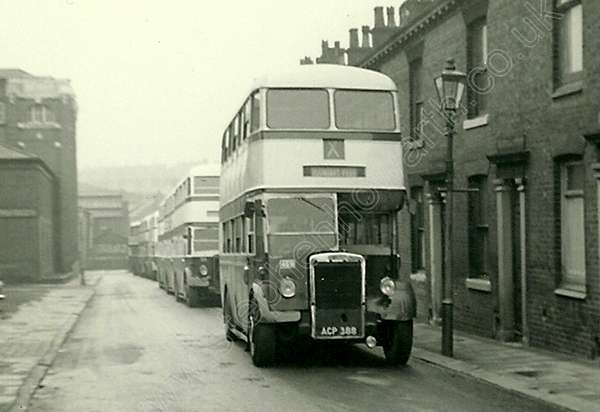
ACP 388 fleet number 469 seen here heading up a line of Football Specials waiting for 'Latics' fans to return after a match.
'X' was the service designation used for special workings and Depot journeys.
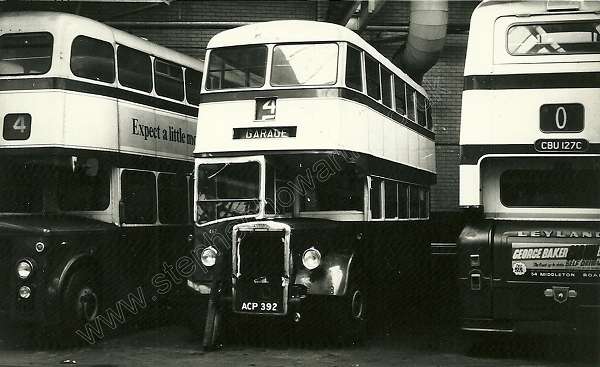
ACP 392 fleet number 467, with chromed radiator, parked at the rear of Wallshaw Street Garage. Next to it on the right is CBU 127C a Leyland Atlantean with Roe H43/34F bodywork
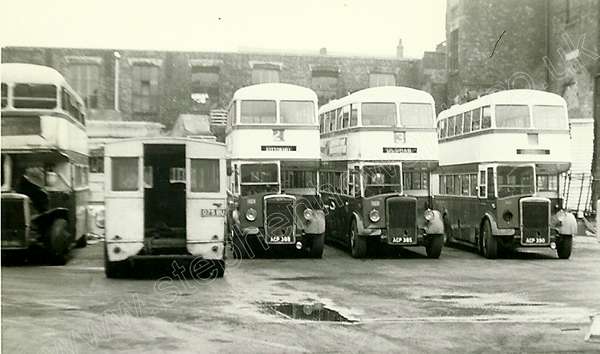
A line up of withdrawn ex Halifax buses. From the left ACP 388, ACP 390 and ACP 390 Fleet Numbers 469, 465 & 470. The bus far left is 108 HBU which overturned in an accident with a tanker on 3rd November 1967, its remains were to remain well into SELNEC days. 075 BU is 'The Red Biddy' tow truck.
02/08/14 - 06:24
A very interesting article with superb photographs by Roger. I always found the routes around Halifax fascinating; what other municipal fleet operated to such interesting places as Booth, Midgeley, Heptonstall, Steep Lane, Rishworth and Mill Bank, not to mention the ex-Hebble routes to Rochdale and Burnley. What a pity that these routes are nowadays mostly operated by Optare Solos.
Stephen, I am puzzled by your statement that ACP 385 became Oldham Corporation 465; According to David Wayman's 1997 book "Oldham Corporation Buses" and also from my own memories, this bus was Oldham 468, and on your "after withdrawal" photo the fleet number looks like 468. David Wayman's book shows Oldham 465 as ex-Sheffield LWE 110.
Don McKeown
12/08/14 - 05:52
One can only say one thing about this article, absolutely excellent.
Here is two more interesting place names that could be found on Halifax destinations Hubberton and Cunning Corner.
Trevor Knowles
12/08/14 - 15:16
The last Halifax Fleetline is currently in store at Keighley bus museum awaiting restoration. There is a recent shot of it on www.sct61.org.uk
Chris Hough
13/08/14 - 07:14
Just look at the photo' of Dennis Loline 303 above: "Crossfield Bus Station"! - just how parochial is that? I never heard anybody refer to the old Halifax Bus Station as Crossfield Bus Station (despite the fact that's what the signage on it side used to boldly-state) And doesn't the style of lettering imply "Crossfield: Bus Station"? not very helpful for strangers is it?? . . . or even for the uninitiated in Huddersfield, from where the bus has just come.
Interesting is the continuation of orange along/over the near-side front mud-gard, to match the off-side from the front . . . I've never seen that before.
Philip Rushworth
13/08/14 - 13:06
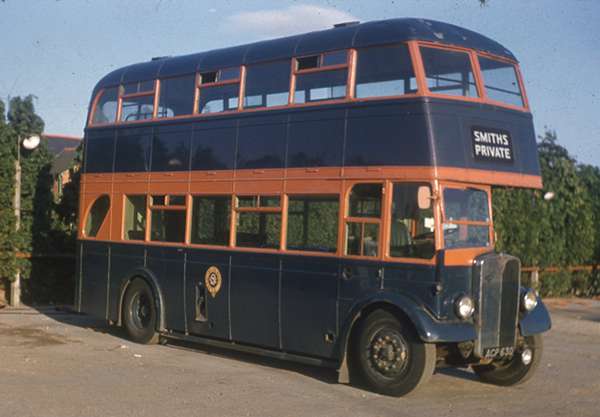
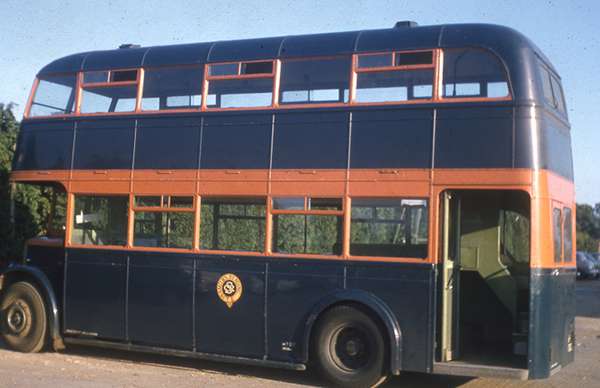
Smiths of Reading ran ACP 627 and ACP 630 until 1964-5. They went beautiful and were the first preselects I'd ever driven. The good-looking, rationally laid out Roe bodies were the icing on the cake.
Ian T
14/08/14 - 06:52
Thank you Ian T. for posting the photos of the Halifax Regent III whilst with Smith's of Reading. Though I have black and white photos of them they don't do them justice, and its very nice to see what they looked like in colour.
As you say they were nice buses. Having been withdrawn way back in 1958, Smith's bought them from North's the Yorkshire dealer in 1959 and got good service out of them, running them until 1965.
Smith's also bought one of the Park Royal-bodied Regents at the same time, but from the London dealer A.M.C.C. ACP 410, formerly HJOC 226 ran with Smith's until 1963.
John Stringer
04/02/15 - 10:23
I feel that it's about time that I expressed my thanks publicly to John Stringer for his superb articles on Halifax Passenger Transport. There is much within that I did not know, not only in respect of the public transport scene, but also of the socio-economic history of this extraordinary area of West Yorkshire. The credits for these Halifax articles are given in reverse order - John's name should definitely be first. During my limited time in the Yorkshire area in the mid 1960s, plus occasional visits in later years, I took a number of pictures of Yorkshire and Lancashire operators, and these shots subsequently languished unseen in my possession for up to half a century. When I came across OBP, it seemed the ideal place to share some of my photos, but, in the cases of both the white and red rose counties, I lacked the background knowledge to pen a meaningful accompanying text - simply stating the obvious seemed decidedly inadequate. I therefore decided to try to approach those OBP contributors whose credentials in this area were clearly impeccable. My first collaboration was with Phil Blinkhorn, and I was extremely gratified by the welcoming reception that Phil gave to my idea. The superbly written, expansive articles that Phil supplied to go with my Manchester area pictures may be found elsewhere on OBP, and I cannot thank him enough. Emboldened by this result, I approached John Stringer with a proposal for a similar project in respect of Halifax. John's exceptional knowledge of the area was clear from his perceptive contributions to OBP, and his positive response was splendid. I am very glad that my pictures from many years ago should have lately become the catalyst for such detailed and enlightening articles from Phil and John.
When I arrived from Croydon, after four and a half years with London Transport at Reigate, to take up the position of Traffic Clerk in Halifax in December 1964, I possessed only a motor cycle licence - I hadn't even driven a car. My first experience behind the wheel of a Halifax bus took place early in 1965 in PD2 ACP 391, originally No.107 until an unscheduled encounter with the Greetland railway bridge in 1963 resulted in its subsequent emergence as an open topper for driver training and tree lopping purposes. By then, this bus was almost 18 years old, and its later career as a trainer had effectively removed much of the remaining synchromesh in the gearbox. My initial attempts probably helped this process along quite dramatically. On my first trip out, Instructor Arthur Brearley took it up to Saville Park, or "The Moor" as it was locally known, and handed it over to me in, if my recollections are correct, Manor Heath Road. I got it up to third gear and proceeded ahead cautiously without incident in a westerly direction, but he then told me to turn left at (I think) Queens Gate. As a bus enthusiast almost from the nappy stage, I knew that turning the corner with a bus required several rotations of the steering wheel, and, after dropping down efficiently into second gear, I attempted to undertake this manoeuvre, only to discover that Leylands were not designed to be steered by seven stone weaklings. I managed to shift direction by about ten degrees, before mounting the grass and mercifully stalling the thing. After that inauspicious start, matters could only improve, and I felt that I had mastered the heaviness of Leyland controls until we went out in Leopard No.231. I pulled away from Skircoat Road in second gear and then found that I couldn't move the gearstick at all. I was told that the gearbox in this bus, which was effectively the prototype Leopard, was virtually solid until the oil and internals had warmed up, and even then a course of muscle building steroids would greatly assist the process. Thankfully, the later Leopards, despite heavy controls, were rather better. The Worldmasters were straightforward to drive once one got used to the marked delay in the response from the gearbox to movements of the selector lever. Somewhat later, when a couple of ex Sheffield AEC Monocoaches arrived, I found these to be very much nicer in every respect than the single deck Leylands.
When still under training, we went out one day in a Nimbus, and I took to this little bus instantly. All the controls were light, and the six speed gearbox responded to sympathetic and gentle treatment. This was in complete contrast to the brute force often required with the Leylands that predominated in the fleet, and the majority of drivers seemed unable to adapt their technique to suit the Nimbus. The little Albions were almost universally despised by the driving force, and when they were despatched elsewhere owing to their mechanical fragility, staff morale rocketed dramatically. I, however, loved them, and was always ready to work a vacant Heptonstall duty with one. Happily, I reacquainted myself with the Nimbus a few years later when moonlighting at weekends for North Downs around Horsham.
I tended to differ from the majority view in respect of other types also. To the average driver, if such a creature exists, the "best bus" is the fastest bus. Because of the exceptionally severe gradients found in much of the territory, the Halifax bus fleet had differentials of about 6.5 :1, which placed a distinct limitation upon maximum speed. The PD2s/PD3s/Regent IIIs/Daimler CVL6s would do about 36-38 mph, the Regent Vs about 40mph (with an accompanying racket that suggested more like 60mph), but the CVG6s resolutely refused to exceed 32mph, even downhill. In contrast to the loosely governed 1800 maximum rpm of the AEC and Leyland engines, the Gardner 6LW was rigidly governed to 1700 rpm and had an all speed governor which was set by the accelerator pedal. For example, pressing the pedal halfway would set the governor to, say, 1300 rpm, and once the engine reached that speed the governor would cut in, the effect being felt by the driver by the noticeable increase in the resistance of the accelerator to foot pressure. One could feel the resistance build up under one's foot as the engine speed increased. The Gardner governor was extremely effective, and nothing would induce the engine to exceed the 1700 rpm maximum, so charging downhill for extra speed to make up time, always possible to some degree with the other types, did not work with a CVG6. Adding to this the engine's modest 112 bhp, and the occasional unpredictability of the spring loaded preselector (it could really hurt when the pedal came out 'half a mile'), there resulted a combination of features that did not make for a bus popular with the driving staff. Ever perverse, I, a strong Gardner fan, loved them, particularly the later Roe bodied examples, and tried to get one whenever possible. I recall taking over a Hebden Bridge bound Regent V in George Street one Saturday, where the departing driver warned me that the engine was leaking exhaust fumes into the cab. Rather than run late or lose mileage, I took the thing on, and soon regretted doing so. Back at Crossfield Bus Station on the return trip to Brighouse, and dizzyingly high on carbon monoxide, I sought a replacement from the bus park, and was told to take whatever I liked. From a choice of an old Regent III, a PD2 and a CVG/Roe, I picked the Daimler, and off we went, not entirely to the satisfaction of the conductor who now had an open platform rather than a cosy folding door. Sadly, there was some kind of parade in Brighouse and we were seriously delayed before leaving again for Halifax where we were to be relieved. Nothing I could say to the relieving driver would convince him that our late arrival was down to congestion in Brighouse. To him, it was the fault of the 'slow Daimler', and he couldn't understand why I hadn't taken absolutely anything else instead from the bus park as a replacement for the dodgy Regent V. He departed for Hebden Bridge in high dudgeon, and such minimal stock as I possessed thus plummeted further. The 'B' (Joint Committee) fleet always seemed to owe mileage to the 'A' (Corporation) fleet, and, in retrospect, I can see that I contributed to this imbalance by choosing Roe Daimlers as replacements for faulty 'B' fleet AECs and Leylands whenever I could.
Geographically, the old Halifax Borough was a place encompassing extraordinary contrasts. To the south, the boundary ran through urban development on the brink of the Calder valley, quite close to the town centre, whereas, to the north and west, the borough swept out to embrace swathes of wild Pennine moorland. Though I did often drive on the Corporation 'A' services when covering duties on the road, my preference was for the out of town 'B' services, particularly the Brighouse - Hebden Bridge 48/49 routes, which were normally the province of the PD3 and Regent V 30 footers. The PD3 was by far the quieter beast of the two, and the more predictable, except in the braking department. Why Leyland, back in its Spurrier days, never attended to the serious lack of retardation in this chassis is surely astonishing. The Regent V brakes were snatchy and poorly progressive, but they were a bit better than the Leyland effort. Even so, on my sundry trips into Bradford as a passenger by Hebble Regent V, my knuckles would go white gripping the handrail as the bus plummeted headlong down the gradients along the Queensbury route. Unlike those sitting nonchalantly around me, I knew just how borderline such driving techniques really were. Only subsequently, on reading the reminiscences of Geoffrey Hilditch on the subject of Hebble maintenance standards, did I realise that my disquietude on those occasions fell well short of reality. The Regent V had light, positive steering and a fully synchromesh gearbox, but the howl from the latter in concert with the raucous engine played havoc with the eardrums. I was not a fan. By contrast, the PD2 was a fundamentally sound piece of machinery and taking one along the windy ridge to Queensbury or up the slopes above the Calder and Ryburn valleys to places such as Barkisland, Midgley, Norland, Sowerby et al, was eminently satisfying, especially on those sadly rare climatic occasions when clear views might be had across the dramatic scenery. It was all so long ago now, but I cannot imagine being enthused today by a driving duty around Halifax in any of the modern mechanical nonentities.
Roger Cox
06/02/15 - 07:00
Thanks Roger for your kind words. It was a pleasurable trip down memory lane for me.
Phil Blinkhorn
06/02/15 - 07:00
I always appreciate both John's and Roger's postings regarding HPT. The Halifax Fleetlines pictured in this thread have that elaborate Daimler badge at the front - which I believe Daimler charged extra for . . . and which one operator refused to pay for, and refused to return the removed badges until the cost was deducted from the invoice. There are some Oldham PD2s pictured on one of the threads: I was driving though Oldham today, and at the A62/IRR roundabout the First Wright-thingy in Oldham heritage livery went past - I must say that the pommard-cream livery looked superb (I can think of better liveries, but in comparison to the battleship-grey "dazzle" camouflage that is First's most recent livery . . .)
Philip Rushworth
06/02/15 - 17:11
Very pleasing to read that First had made some effort to recognise Oldham's centenary.
That's in marked contrast to Stagecoache's apathy on the subject of Stockport's centenary of bus operations in 2013 (perhaps they thought that trolleybuses don't count!)
Orla Nutting
07/02/15 - 06:14>
Living not far from Halifax I found this of great interest, although I've only briefly driven a bus, and that in the Barnsley area.
First has several buses in heritage liveries in South and West Yorkshire and others in Leicester and Swansea. There may well be others. The First Manchester website has a heritage page with a brief note on the operators (municipal plus LUT) whose liveries they are commemmorating.
Geoff Kerr
07/02/15 - 06:15
I must thank Roger for asking me to collaborate with the article, and for his appreciative comments, and also to thank all those others who have commented favourably. Thank You.
John Stringer
18/01/17 - 17:39
How fantastic to read something as well written as this.
Thank you guys so much for sharing your thoughts and giving such a tremendous set of historical references.
My only regret - I have only just now found the articles on the site.
I am inspired to continue documenting/publishing my recently discovered notebooks from the 1960's.
Thanks again to all concerned, good job!
Stuart Emmett
If you have not read this article from the beginning, click here, you won't be disappointed.
Comments regarding the above are more than welcome please get in touch via the 'Contact Page' or by email at
If you have a bus related article that you would like to appear on this site please get in touch via the 'Contact Page' or by email at
All rights to the design and layout of this website are reserved Old Bus Photos does not set or use Cookies but Google Analytics will set four see this
Old Bus Photos from Saturday 25th April 2009 to Friday 26th April 2024